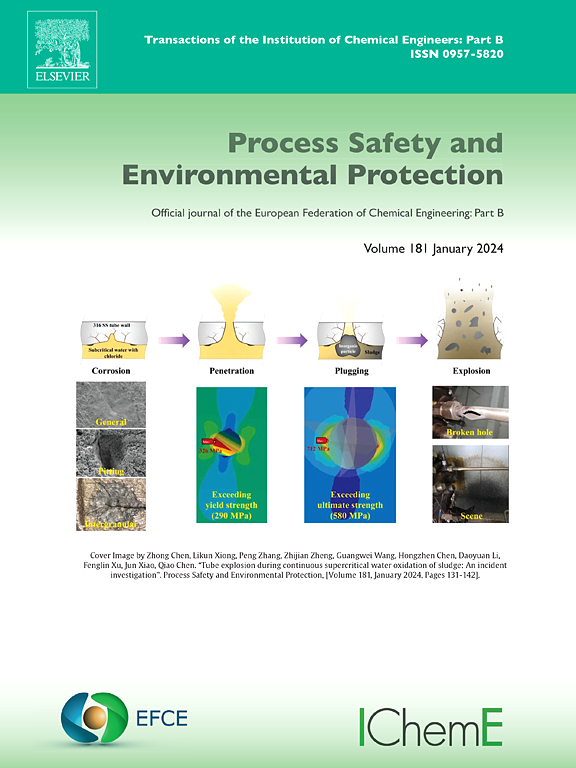紧凑密闭氢电耦合系统中氢气泄漏及爆炸事故后果的数值模拟
IF 7.8
2区 环境科学与生态学
Q1 ENGINEERING, CHEMICAL
引用次数: 0
摘要
以往的氢安全研究通常集中在加氢站、车库等场景,这些场景通常位于开放、半开放空间和简单的密闭空间。然而,在设备布局复杂的密闭空间内,氢气泄漏的扩散特性和事故后果尚不清楚。本文采用数值模拟的方法对密闭空间内氢气泄漏、扩散和爆炸特性进行了评价。探讨了泄漏位置、泄漏直径、容器尺寸和通风出口布局对氢气泄漏和扩散特性的影响。进一步研究了集装箱尺寸和通风出口位置对降低爆炸危险性的影响,最终确定了最佳的集装箱尺寸和通风出口布置。结果表明,与宽敞的空间相比,氢气在拥挤的空间中泄漏时,会被障碍物阻挡,并在局部积聚。氢气爆炸最严重的后果是固态储氢系统发生大规模泄漏,造成超压2630 kPa,破坏半径25 m。增加容器尺寸并加入强制通风系统有效地降低了氢气浓度,减轻了氢气爆炸的后果。与将出风口放置在侧壁相比,将出风口放置在顶部通风效率更高,安全保护效果更好。该研究为紧凑密闭空间内hes通风系统的选择和布局提供了有价值的见解。本文章由计算机程序翻译,如有差异,请以英文原文为准。
Numerical simulation of hydrogen leakage and accident consequence of hydrogen explosion in compact confined hydrogen-electric coupling systems
Previous hydrogen safety research typically focuses on scenarios such as hydrogen refueling stations, garages, and so on, which are usually located in open, semi-open spaces and simply confined spaces. However, the diffusion characteristics of hydrogen leakage and the consequences of accidents in hydrogen-electric coupling system (HECS) within a compact confined space with complex equipment layouts remain unclear. This study evaluates the characteristics of hydrogen leakage, diffusion, and explosion in HECS within a compact confined space based on numerical simulation. The effects of leakage positions, leakage diameters, container sizes, and ventilation outlet layouts on the hydrogen leakage and diffusion characteristics are explored. Furthermore, this study investigates the effects of container size and ventilation outlet positions on reducing explosion hazards, and ultimately determines the optimal container size and ventilation outlet arrangement. The results show that compared to a spacious space, when hydrogen leaks in a congested space, it is blocked by obstacles and accumulates locally. Furthermore, the most severe consequence of hydrogen explosion occurs due to large-scale leakage in the solid-state hydrogen storage system, resulting in an overpressure of 2630 kPa and a damage radius of 25 m. Increasing the container size and incorporating forced ventilation systems effectively reduce the hydrogen concentration and mitigate the consequences of hydrogen explosions. Compared to placing the ventilation outlet on the sidewall, placing it on the top results in higher ventilation efficiency and better safety protection. This study provides valuable insights into the choice of container and the layout of ventilation systems in HECS within the compact confined space.
求助全文
通过发布文献求助,成功后即可免费获取论文全文。
去求助
来源期刊

Process Safety and Environmental Protection
环境科学-工程:化工
CiteScore
11.40
自引率
15.40%
发文量
929
审稿时长
8.0 months
期刊介绍:
The Process Safety and Environmental Protection (PSEP) journal is a leading international publication that focuses on the publication of high-quality, original research papers in the field of engineering, specifically those related to the safety of industrial processes and environmental protection. The journal encourages submissions that present new developments in safety and environmental aspects, particularly those that show how research findings can be applied in process engineering design and practice.
PSEP is particularly interested in research that brings fresh perspectives to established engineering principles, identifies unsolved problems, or suggests directions for future research. The journal also values contributions that push the boundaries of traditional engineering and welcomes multidisciplinary papers.
PSEP's articles are abstracted and indexed by a range of databases and services, which helps to ensure that the journal's research is accessible and recognized in the academic and professional communities. These databases include ANTE, Chemical Abstracts, Chemical Hazards in Industry, Current Contents, Elsevier Engineering Information database, Pascal Francis, Web of Science, Scopus, Engineering Information Database EnCompass LIT (Elsevier), and INSPEC. This wide coverage facilitates the dissemination of the journal's content to a global audience interested in process safety and environmental engineering.
 求助内容:
求助内容: 应助结果提醒方式:
应助结果提醒方式:


